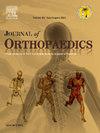Effects of obstructive sleep apnea on postoperative outcomes following total shoulder arthroplasty: A matched cohort analysis
IF 1.5
Q3 ORTHOPEDICS
引用次数: 0
Abstract
Introduction
Obstructive sleep apnea (OSA), marked by recurrent airway obstruction and disrupted sleep, is linked to increased perioperative risk in major surgeries. However, its impact on total shoulder arthroplasty (TSA) remains unclear. This study investigates the association between OSA and postoperative outcomes.
Methods
This retrospective cohort study used the PearlDiver Mariner Database to identify patients who underwent TSA from 2010 to 2021. Patients with OSA were compared to a matched control group without OSA, with matching based on demographics and comorbidities. Postoperative complications, including deep vein thrombosis (DVT), pulmonary embolism (PE), surgical site infection (SSI), transfusions, and revision TSA, were identified using ICD and CPT codes. Multivariate logistic regression was used to adjust for confounders.
Results
A total of 57,118 TSA patients were included, with 50 % (n = 28,559) having a documented diagnosis of OSA. Patients with OSA had a significantly higher prevalence of comorbidities, including hypertension (65.0 % vs. 62.1 %, p < 0.001), obesity (27.3 % vs. 18.8 %, p < 0.001), asthma (8.7 % vs. 4.9 %, p < 0.001), and COPD (17.8 % vs. 14.4 %, p < 0.001). The incidence of DVT, PE, SSI, and wound disruption was not significantly different between groups. However, OSA was associated with a significantly higher risk of revision TSA within two years (0.3 % vs. 0.2 %; OR: 1.43, 95 % CI: 1.04–2.00; p = 0.028). Additionally, OSA patients had a significantly lower rate of blood transfusion (0.6 % vs. 0.8 %; OR: 0.68, 95 % CI: 0.55–0.83; p < 0.001).
Conclusion
OSA does not significantly raise the risk of acute complications after TSA but is linked to a higher rate of revision surgeries, suggesting a role in long-term failure, possibly from poor wound healing, systemic inflammation, or obesity-related stress. Preoperative screening and postoperative optimization may help reduce these risks. Further research is needed to assess the effects of OSA severity and CPAP adherence on TSA outcomes.
阻塞性睡眠呼吸暂停对全肩关节置换术后预后的影响:一项匹配队列分析
梗阻性睡眠呼吸暂停(OSA)以反复气道阻塞和睡眠中断为特征,与大手术围手术期风险增加有关。然而,其对全肩关节置换术(TSA)的影响尚不清楚。本研究探讨OSA与术后预后之间的关系。方法本回顾性队列研究使用PearlDiver Mariner数据库识别2010年至2021年接受TSA的患者。将OSA患者与无OSA的匹配对照组进行比较,并根据人口统计学和合并症进行匹配。术后并发症,包括深静脉血栓形成(DVT)、肺栓塞(PE)、手术部位感染(SSI)、输血和改良TSA,使用ICD和CPT代码进行识别。采用多元逻辑回归对混杂因素进行校正。结果共纳入57,118例TSA患者,其中50% (n = 28,559)确诊为OSA。OSA患者的合并症患病率明显更高,包括高血压(65.0% vs. 62.1%, p <;0.001),肥胖(27.3% vs. 18.8%, p <;0.001),哮喘(8.7% vs. 4.9%, p <;0.001), COPD (17.8% vs. 14.4%, p <;0.001)。两组间DVT、PE、SSI和伤口破裂的发生率无显著差异。然而,OSA与两年内修订TSA的风险显著升高相关(0.3% vs. 0.2%;Or: 1.43, 95% ci: 1.04-2.00;p = 0.028)。此外,OSA患者的输血率明显较低(0.6% vs 0.8%;Or: 0.68, 95% ci: 0.55-0.83;p & lt;0.001)。结论:osa不会显著增加TSA术后急性并发症的风险,但与更高的翻修手术率有关,提示长期失败的作用,可能来自伤口愈合不良、全身性炎症或肥胖相关的压力。术前筛查和术后优化有助于降低这些风险。需要进一步的研究来评估OSA严重程度和CPAP依从性对TSA结果的影响。
本文章由计算机程序翻译,如有差异,请以英文原文为准。
求助全文
约1分钟内获得全文
求助全文
来源期刊

Journal of orthopaedics
ORTHOPEDICS-
CiteScore
3.50
自引率
6.70%
发文量
202
审稿时长
56 days
期刊介绍:
Journal of Orthopaedics aims to be a leading journal in orthopaedics and contribute towards the improvement of quality of orthopedic health care. The journal publishes original research work and review articles related to different aspects of orthopaedics including Arthroplasty, Arthroscopy, Sports Medicine, Trauma, Spine and Spinal deformities, Pediatric orthopaedics, limb reconstruction procedures, hand surgery, and orthopaedic oncology. It also publishes articles on continuing education, health-related information, case reports and letters to the editor. It is requested to note that the journal has an international readership and all submissions should be aimed at specifying something about the setting in which the work was conducted. Authors must also provide any specific reasons for the research and also provide an elaborate description of the results.
 求助内容:
求助内容: 应助结果提醒方式:
应助结果提醒方式:


